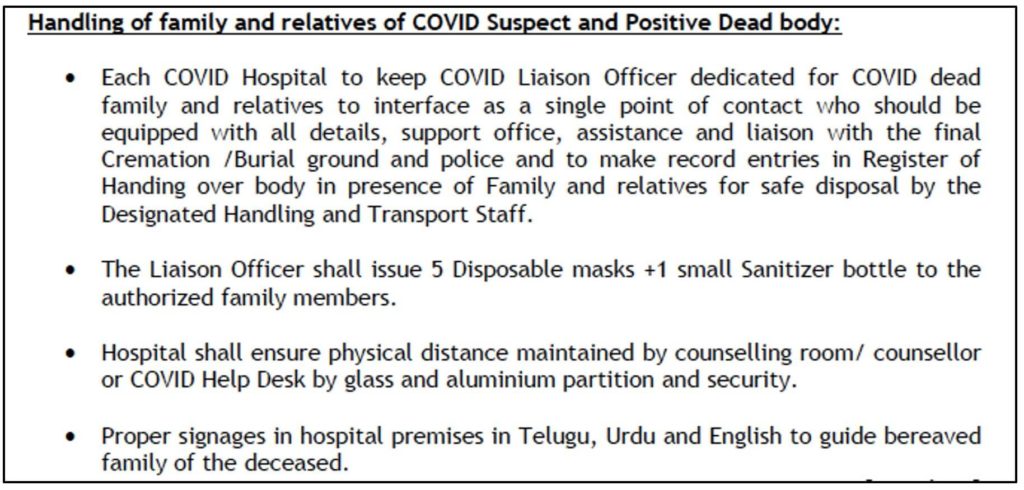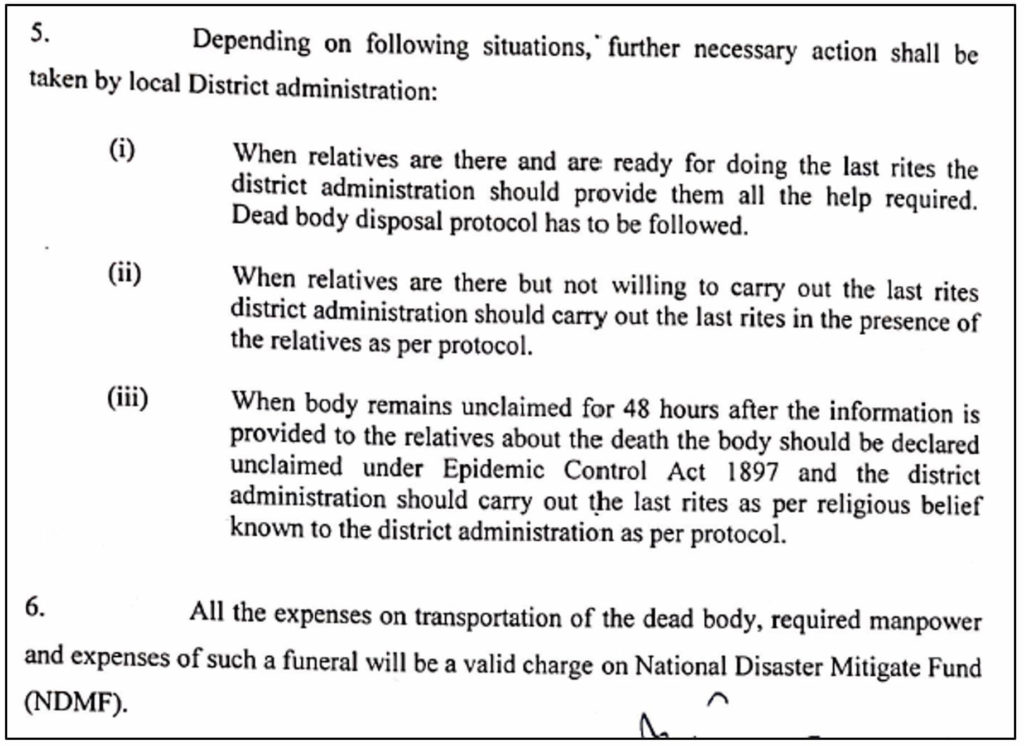The global death toll due to COVID-19 crossed 1.2 lakh. Some countries are grappling with thousands of infected dead bodies as governments across the world have issued detailed guidelines to deal with the dead bodies. Here is an explainer on these guidelines in India & few other countries.
Most health authorities around the globe have released their own set of guidelines regarding dead body management of COVID-19 positives. They are mostly the same with some minor variations. Cremation has been suggested as the safest way for last rites, instead of burial. However, guidelines for burials are also outlined.
Guidelines by GoI and AIIMS
On 15 March 2020, the Government of India released the guidelines for dead body management for COVID-19 including management of bodies in hospital, autopsy, and burial/cremation. Main highlights of the guidelines are:
1.Removal of the body from the isolation room or area
- The health worker attending to the dead body should perform hand hygiene, ensure proper use of Personal Protection Equipment -PPE (water resistant apron, goggles, N95 mask, gloves).
- All tubes, drains and catheters on the dead body should be removed.
- Any puncture holes or wounds (resulting from removal of catheter, drains, tubes, or otherwise) should be disinfected with 1% hypochlorite and dressed with impermeable material.
- Plug Oral, nasal orifices of the dead body to prevent leakage of body fluids.
- Place the dead body in leak-proof plastic body bag. The exterior of the body bag can be decontaminated with 1% hypochlorite.
- The body bag can be wrapped with a mortuary sheet or sheet provided by the family members.
- If the family of the patient wishes to view the body at the time of removal from the isolation room or area, they may be allowed to do so with the application of Standard Precautions.
- The body will be either handed over to the relatives or taken to mortuary.
2. Handling of dead body in Mortuary
- Mortuary staff handling COVID-19 dead body should observe standard precautions.
- Dead bodies should be stored in cold chambers maintained at approximately 4 degree Celsius.
- After removing the body, the chamber door, handles and floor should be cleaned with sodium hypochlorite 1% solution.
3. Autopsies on COVID-19 dead bodies
- Autopsies should be avoided. If autopsy is to be performed for special reasons, the following infection prevention control practices should be adopted:
- The team should use full complement of PPE (coveralls, head cover, shoe cover, N 95 mask, goggles / face shield).
- Round ended scissors should be used. PM40 or any other heavy-duty blades with blunted points to be used to reduce prick injuries.
- Negative pressure to be maintained in mortuary.
- The body thereafter can be handed over to the relatives.
- Autopsy table to be disinfected as per standard protocol.
4.Transportation
- The body, secured in a body bag, exterior of which is decontaminated poses no additional risk to the staff transporting the dead body.
- The personnel handling the body may follow standard precautions (surgical mask, gloves).
- The vehicle, after the transfer of the body to cremation/ burial staff, will be decontaminated with 1% Sodium Hypochlorite.
5.At the crematorium/Burial Ground
- The Crematorium/ burial Ground staff should be sensitized that COVID-19 does not pose additional risk.
- The staff will practice standard precautions of hand hygiene, use of masks and gloves.
- Viewing of the dead body by unzipping the face end of the body bag (by the staff using standard precautions) may be allowed, for the relatives to see the body for one last time.
- Religious rituals such as reading from religious scripts, sprinkling holy water and any other last rites that does not require touching of the body can be allowed.
- Bathing, kissing, hugging, etc. of the dead body should not be allowed.
- The funeral/ burial staff and family members should perform hand hygiene after cremation/ burial.
- The ash does not pose any risk and can be collected to perform the last rites.
- Large gathering at the crematorium/ burial ground should be avoided as a social distancing measure as it is possible that close family contacts may be symptomatic and/ or shedding the virus.
The AIIMS Department of Forensic Medicine and Toxicology, New Delhi, has also released its own set of guidelines. They are mostly the same as GoI guidelines and have some additional points too. In order to ensure safety, they have suggested that it is best to cremate all bodies in electric or gas crematoriums, keeping the body in the body bag. And if burial is to be done, for religious or personal beliefs, the body should be placed in a thick and air-tight coffin at a depth of four to six meters in the ground. The area of the grave should be cemented immediately and precautions should be followed afterwards to avoid scavenging by animals.
In addition to this, the Central Pollution Control Board (CPCB), has released guidelines for handling, treatment and safe disposal of biomedical waste generated during treatment, diagnosis and quarantine of patients confirmed or suspected to have the novel coronavirus disease (COVID-19).
Guidelines by Indian States
All Indian states have issued orders to follow the GoI guidelines. Some states have released more detailed guidelines, such as:
State of Telangana outlined measures to ensure preparedness of government and private hospitals dealing with COVI-19 casualties and handling of family and relatives. The guidelines have specified the number of people who can be allowed for viewing of deceased body (up to 5 people at a time) and during last rites (up to 5 people allowed).


Telangana also outlined how to handle family of deceased persona and directed hospitals to appoint a dedicated COVID liaison Officer for this purpose.

State of Punjab outlined the chain of responsibilities in case of death in Government Medical Colleges and other Isolation Centres.

Punjab’s notification also outlined the role of local District Administration with respect to helping the deceased person’s relatives during last rites and procedure to be followed in case of unclaimed bodies.

Guidelines by World Health Organisation
Apart from similar measures mentioned above, World Health Organisation also outlined the following with respect to the last rites of deceased patients, such as:
- Children, older people (>60 years old), and anyone with underlying illnesses (such as respiratory illness, heart disease, diabetes, or compromised immune systems) should not directly interact with the body.
- People with respiratory symptoms should not participate in the viewing or at least wear a medical mask to prevent contamination of the place and further transmission of the disease to others.
- Although burials should take place in a timely manner, in accordance with local practices, funeral ceremonies not involving the burial should be postponed, as much as possible, until the end of the epidemic.
- The belongings of the deceased person do not need to be burned or otherwise disposed of. However, they should be handled with gloves and cleaned with a detergent followed by disinfection with a solution of at least 70% ethanol or 0.1% (1000 ppm) bleach and clothing and other fabric belonging to the deceased should be machine washed with warm water at 60−90°C (140−194°F) and laundry detergent.
European Union and US Centers for Disease Control and Prevention have released similar guidelines for management of COVID dead body management.
Practices around the world
Nations around the world are still grappling with the best ways to manage the dead body of COVID-19 patients. A few excerpts gained light such as:
- On 12th April, following seven COVID-19 deaths, Sri Lanka made cremations compulsory for coronavirus victims on Sunday.
- In the USA, as rising deaths related to the COVID-19 outbreak added high demand for mortuary space, the D.C. region officials came up with the idea to use ‘mobile body storage trailers’. New York city also followed a similar model in the face of a high number of COVID-19 casualties.
- Memorial and funeral processes have changed in subtle but important ways since COVID-19 struck America. In order to brace the influx of COVID-19 deaths, families of people who die from any cause, not just COVID-19, are being urged to scale back their memorial services, postpone funeral services, limit the number of people who can attend and increasingly using online tools.
- Many funeral homes are severely restricting the number of people allowed to gather for visitations, memorials, and funerals, or offering alternative options like livestreaming. For instance, a funeral home in Buffalo, New York, where the service is being held, is offering only two visitation options: Mourners can either walk past the casket one at a time, or drive by in their cars.
- In UK, a number of councils are banning funeral ceremonies because of the coronavirus crisis. Bradford, Leeds and Kirklees councils have said families will no longer be able to attend services at crematoria. A ‘direct cremations’ will be offered, in which there is no ceremony and mourners are not present; and burial services at gravesides, with a maximum of 10 mourners observing physical distancing guidelines.
Featured Image: COVID-19 Dead Body Management


